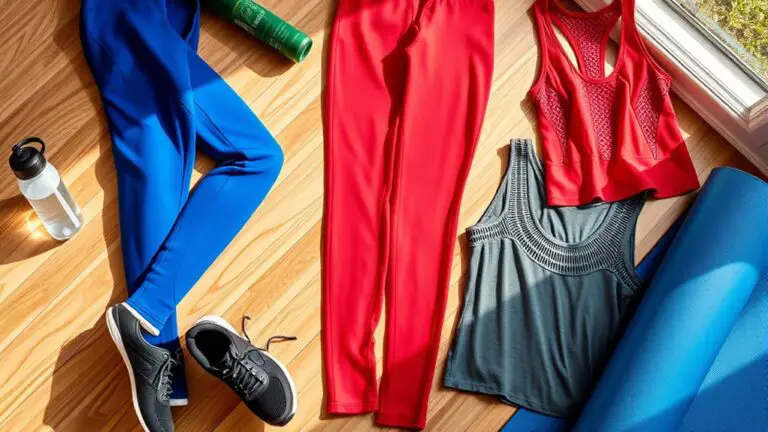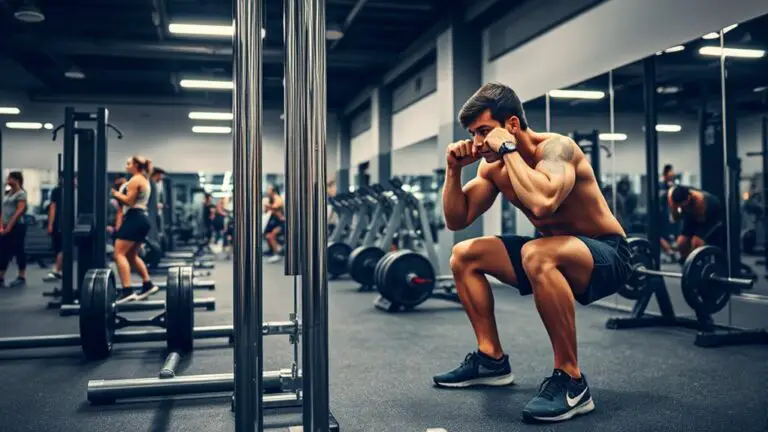The Pros and Cons of Wearing Compression Gear in the Gym

Wearing compression gear in the gym offers several benefits, such as improved blood circulation and enhanced muscle support, which can boost performance and speed up recovery. However, it can cause discomfort if it doesn’t fit properly or leads to skin irritation with prolonged wear. Proper sizing is vital to maximize advantages and minimize drawbacks. Understanding how to effectively integrate compression gear into your routine is essential for ideal training outcomes—explore the nuances of this gear for better performance results.
Understanding Compression Gear: What It Is and How It Works
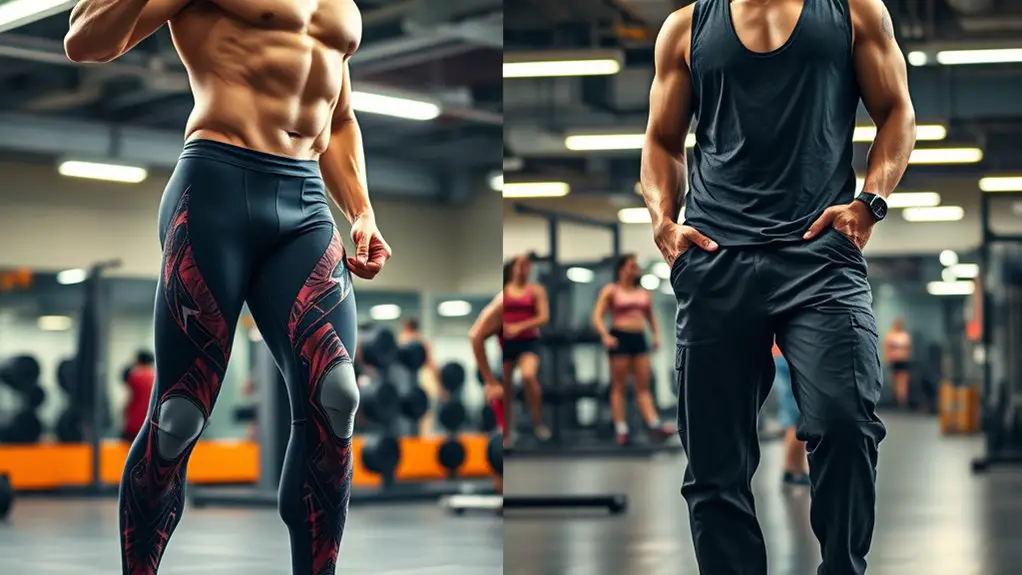
Compression gear has gained popularity in the fitness community for its purported benefits in performance and recovery. Understanding the various compression gear types is essential for making informed choices. Common types include compression socks, sleeves, and full-body suits, each designed to apply graduated pressure to specific muscle groups.
The effectiveness of compression gear largely depends on its materials. Most garments are crafted from a blend of spandex, nylon, or polyester, providing elasticity and moisture-wicking properties. These materials enable the gear to fit snugly while allowing for breathability, which is critical during intense workouts.
When selecting compression gear, consider factors such as the intended use, duration of wear, and personal comfort. By understanding these components, you can better assess how compression gear might fit into your fitness regimen, ensuring you choose the right type and material for your specific needs.
Benefits of Compression Gear for Performance
As athletes seek ways to enhance their performance, the adoption of compression gear has emerged as a significant trend. This type of apparel is designed to provide muscle support through graduated compression, which can improve blood circulation. Enhanced circulation delivers more oxygen to your muscles, potentially boosting endurance and delaying fatigue during workouts.
Research indicates that wearing compression gear can lead to improved proprioception, helping you maintain better body awareness and stability. This may translate to more effective movement patterns and reduced risk of injury. Furthermore, compression clothing can minimize muscle oscillation during high-impact activities, which can enhance overall performance by providing a stable environment for your muscles.
Advantages of Compression Gear for Recovery

When you use compression gear post-workout, you’ll likely notice enhanced blood circulation, which aids in nutrient transport and waste removal. This improved blood flow can greatly reduce muscle soreness, allowing you to feel more comfortable as you recover. Consequently, many athletes experience faster recovery times, enabling them to train more consistently and effectively.
Enhanced Blood Circulation
While you may not realize it, enhanced blood circulation is one of the key benefits of wearing compression gear during and after workouts. Compression garments apply controlled pressure, which can greatly improve blood flow to the muscles. This increased circulation facilitates better muscle oxygenation, allowing your body to deliver essential nutrients more efficiently. Research shows that enhanced blood flow helps remove metabolic waste products, promoting faster recovery. By wearing compression gear, you’re likely to experience improved endurance during workouts and a more effective post-exercise recovery phase. This physiological response can be particularly beneficial for athletes looking to maximize performance and minimize downtime. Overall, compression gear serves as a practical tool for optimizing circulatory efficiency and supporting your fitness goals.
Reduced Muscle Soreness
Compression gear has been shown to notably reduce muscle soreness after intense workouts, making it a valuable asset for recovery. Studies indicate that wearing compression garments can mitigate muscle fatigue by enhancing proprioception and minimizing vibrations during exercise. This reduction in muscle oscillation leads to decreased microtrauma in muscle fibers, which is a primary contributor to delayed onset muscle soreness (DOMS). As a result, you’re likely to experience effective soreness relief, allowing you to maintain a consistent workout schedule without prolonged discomfort. The graduated compression design improves blood flow, facilitating the removal of metabolic waste products that accumulate during strenuous activity. Overall, incorporating compression gear into your routine could notably enhance your recovery and performance outcomes.
Faster Recovery Times
Following the reduction of muscle soreness, faster recovery times represent another significant advantage of utilizing compression gear during and after workouts. Compression garments enhance blood flow, which is essential for optimizing recovery timing. Improved circulation facilitates the delivery of oxygen and nutrients to your muscles, accelerating the muscle repair process. Research indicates that athletes wearing compression gear experience reduced recovery periods compared to those who don’t. This is critical for maintaining training frequency and intensity, allowing you to hit your goals sooner. Additionally, compression can help minimize the buildup of lactic acid, further aiding in quicker recovery. Ultimately, integrating compression gear into your routine can enhance your performance by promoting more efficient muscle repair and reducing downtime between workouts.
Potential Drawbacks of Using Compression Gear
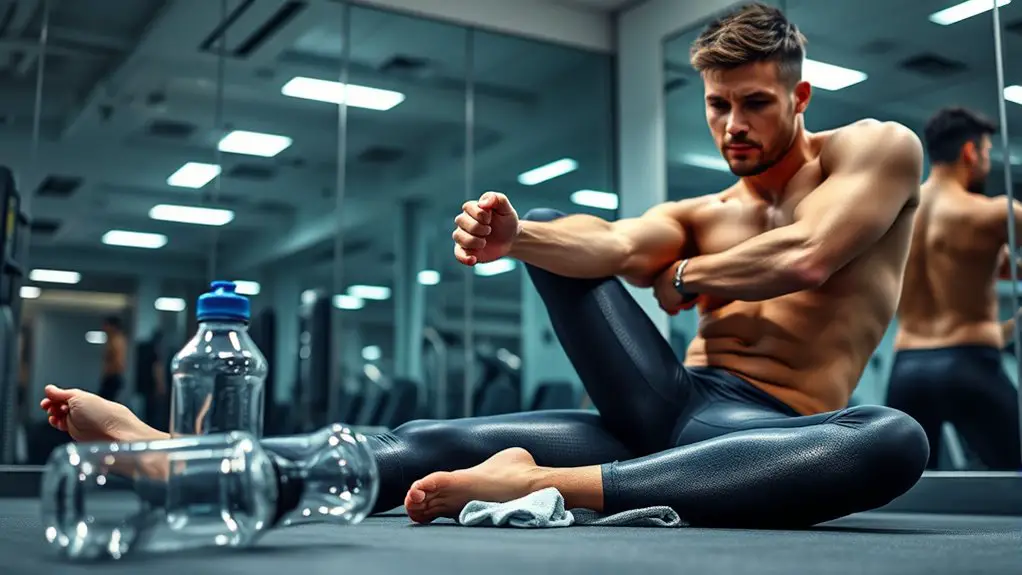
Though many athletes swear by compression gear for its benefits, it’s vital to evaluate the potential drawbacks that could impact your performance and comfort. One significant concern is the discomfort levels associated with prolonged use. Compression garments are designed to fit tightly, and while this can enhance blood flow, it may also lead to a sensation of constriction that some find distracting. Additionally, skin irritation is a common issue, particularly if the fabric is not breathable or if the gear is worn for extended periods. Friction between the skin and the material can exacerbate this, especially during high-intensity workouts. Moreover, improper sizing can lead to excessive pressure, which might hinder circulation rather than improve it. Ultimately, while compression gear can offer benefits, understanding these drawbacks is essential to guarantee they don’t negatively affect your training experience.
How to Choose the Right Compression Gear for You
When selecting compression gear, it’s essential to contemplate the specific activity you’ll be engaging in, as different sports require varying levels of support. Additionally, ensuring the correct size and fit is important; improper sizing can negate the benefits of compression and potentially lead to discomfort. By focusing on these factors, you’ll enhance your performance and recovery.
Consider Your Activity Type
Choosing the right compression gear is essential, as it can considerably impact your performance and recovery during various activities. Start by evaluating the activity specificity of your workouts. For high-intensity sports like sprinting or weightlifting, targeted compression in areas like the calves or thighs can enhance blood flow and reduce muscle vibration. Conversely, for endurance activities such as running or cycling, full-leg compression may provide better support and minimize fatigue. Consider sport suitability as well; different sports impose unique demands on your body. For instance, a triathlete might benefit from a combination of upper and lower body compression, while a yoga practitioner might prefer lighter gear for flexibility. Tailoring your choice based on these factors can optimize your training outcomes.
Check Size and Fit
Getting the right size and fit for your compression gear is essential for maximizing its benefits. Start by taking accurate size measurements of key areas such as your chest, waist, hips, and thighs. Many manufacturers provide sizing charts that correlate these measurements to their products. Make sure that the gear fits snugly without being overly tight—this can help enhance blood circulation and muscle support. If you find the initial fit isn’t ideal, consider fit adjustments through different sizes or styles. Remember, the goal is to achieve a balance between compression and comfort. A proper fit can prevent chafing and enhance performance, making your workouts more effective and enjoyable. Prioritize precision in sizing to fully leverage the advantages of compression gear.
Balancing Compression Gear Use With Traditional Training Methods
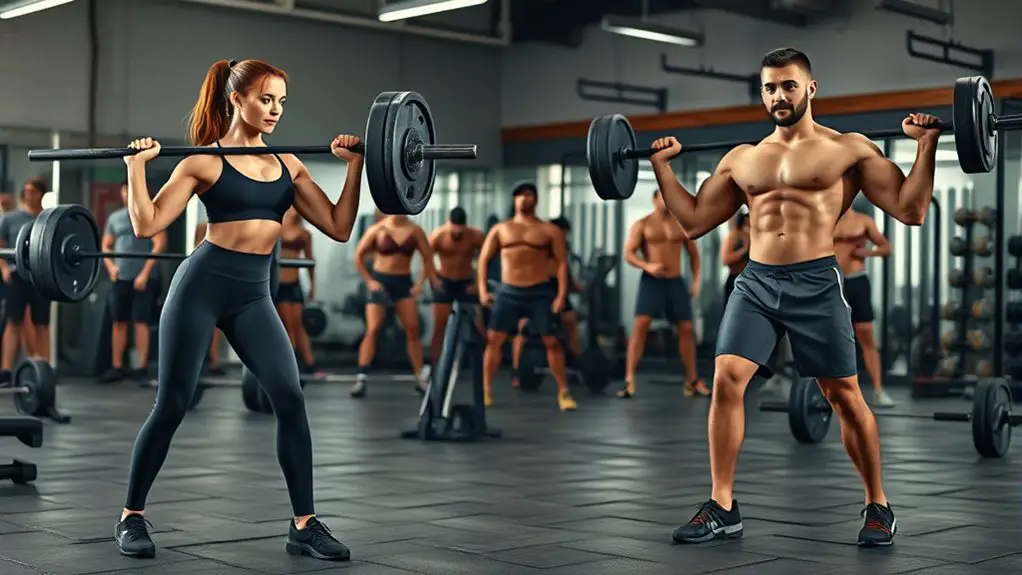
While incorporating compression gear into your training regimen can enhance performance and recovery, it’s vital to strike a balance with traditional methods to guarantee well-rounded fitness. Compression gear versatility can improve blood circulation and reduce muscle soreness, yet it shouldn’t replace foundational training principles. Emphasizing strength, flexibility, and endurance through traditional exercises is fundamental for overall development.
Integrating various training methods allows for a more thorough approach; for instance, you might wear compression sleeves during high-intensity interval training but rely on free weights for strength training. This combination guarantees that while you benefit from the support of compression gear, you’re also engaging in exercises that challenge your body in multiple dimensions.
Ultimately, successful training method integration hinges on understanding when to utilize compression gear and when to emphasize body mechanics and functional strength. Adopting this balanced approach will optimize your gym experience and fitness outcomes.
Frequently Asked Questions
Can Compression Gear Help Prevent Injuries During Workouts?
Compression gear can aid in injury prevention by providing muscle support during workouts. Studies suggest that the tight fit may enhance blood circulation, which can reduce muscle fatigue and improve recovery times. By stabilizing muscles and joints, compression wear may help minimize the risk of strains or sprains. However, individual responses vary, so it’s essential to evaluate personal comfort and fit when deciding if compression gear is right for your exercise routine.
Is There an Optimal Time to Wear Compression Gear?
When considering ideal timing for wearing compression gear, you should focus on your workout duration and the intensity of your activities. Studies suggest that wearing compression gear during prolonged workouts can enhance blood circulation and reduce muscle fatigue. It’s beneficial to wear it before your workout for muscle warmth, during to support performance, and after for recovery. This strategic approach maximizes the benefits, ensuring you’re getting the most out of your training sessions.
How Should I Care for My Compression Gear?
So, you think tossing your compression gear in with your regular laundry’s a good idea? Think again! To care for it properly, stick to gentle washing techniques—cold water’s your best friend. Avoid fabric softeners; they’ll ruin the elasticity. For drying methods, lay it flat or hang it up; don’t toss it in the dryer. Following these guidelines will guarantee your gear lasts longer and continues to support you effectively during workouts.
Are There Specific Types for Different Sports or Activities?
Yes, there are specific compression types designed for different sports, each offering sport-specific benefits. For instance, runners often use calf sleeves to enhance circulation and reduce muscle fatigue, while cyclists might prefer compression shorts for improved muscle support and reduced chafing. Athletes in high-impact sports may benefit from compression tops that stabilize the core and upper body. Choosing the right gear can enhance performance by addressing the unique demands of your activity.
Can Wearing Compression Gear Cause Any Skin Issues?
Studies suggest that about 10% of athletes experience skin irritation from compression gear. While these garments offer benefits, they can lead to issues like skin irritation and allergic reactions, particularly if they’re made from synthetic materials or worn for prolonged periods. It’s crucial you choose high-quality fabrics and guarantee a proper fit. Regularly checking your skin for any signs of discomfort can help prevent these issues and maintain your overall skin health.
